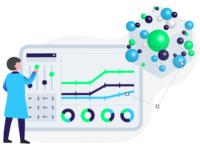Data Sharing in the Coatings Industry




The Landscape is Changing for Coatings Companies
In a digital world, with new consumer demands and a focus on sustainability, change is afoot. We’ve already seen fashion, banking and many other industries grapple with digitization and data sharing. With all this happening around them, how are companies in the coatings industry managing, and what’s the outlook for the future?
Merit van der Lee of RheoCube, and Dr. Ulf Stalmach of ORONTEC GmbH & Co. KG took some time to think about these questions. They looked at the industry’s modus operandi, the impact of digital, and the potential for data sharing along the value chain. Their findings offer some interesting insights on the current state of play and what’s going to count in the future.
How Companies in the Industry Currently Organize Their R&D
Overall, a siloed approach exists at the moment. Experimentation is generally carried out in the R&D department, which lives as a separate entity in the organization. That reduces the connection to clients, production or other departments with insights on the customers’ needs. It also hampers innovation. If people had the right data and visualization tools, new ideas could move much faster.
Companies in the sector also rely heavily on information provided by raw materials suppliers, but that information often lacks detail. Suppliers might want to shield a product’s ingredients from competing suppliers. Coatings manufacturers may also be reluctant to share data on the end product. There’s a feeling that confidentiality should be maintained.
Imagine however, if there was more transparency along the supply chain. Researchers in coatings companies would get a deeper understanding of materials used in the final product. Suppliers would know what’s needed to make a better end product. Both parties could fast track their continuous improvement efforts. In the end, the entire industry would benefit.
Simulation Software Can Help, But How?
Simulations offer huge capacity to break down those silos and reduce the number of testing cycles. They do so by deepening the understanding of how different scientific parameters interact in a material. A simulation helps to interpret results and shows where to tweak parameters to get a mixture to work. Researchers can use digital simulations to understand, ask the right questions, create hypotheses and verify. Trial-and-error is not totally done away with, but it is given real direction and made much more effective.
Simulations also offer a more robust, scientific way of measuring things. Phenomena in a formulation are seen on screen, in graphs or in video format. Even non-modeling experts can tweak parameters and see interactions at minute levels. That’s a game changer in today’s fast-moving markets.
If R&D personnel have fixed starting points for measuring phenomena, they can spot deviations earlier and eradicate literally thousands of unnecessary lab tests. The results speak for themselves. If the number of testing cycles drops dramatically, cost and time savings are substantial.
There’s also the benefit of having a place to store insights collected over multiple experiments. Such information becomes a valuable component of organizational learning. Knowledge that takes years to build up is kept for every formulator in the company to use. A central point like this also reduces duplication of effort. Scientists can access information online, or connect to a person with the knowledge they need. For a given experiment they can see the ingredients, or how a sample was prepared. Shared experiences reduce the workload for everyone.
Data Sharing Matters — and There’s No Need to Fear It
Even if raw material suppliers were to share information on the chemistry in their products, there’s a lack of understanding amongst buyers on the right questions to ask. So, we are left with complex systems and limited understanding of interactions or other events that happen within them. The magic phrase here is ‘transparency of data.’
There are two key reasons for sharing data. Firstly, instead of re-doing the same research individually, a repository of data could be created for everyone. Secondly, the quality of results from using AI increases with the number of data points available. Joining forces in this way gives all parties in the value chain a valid, solid base of information.
The average SDS is a good starting point. Data could be shared on formulations, detailed enough so the properties of formulations make sense but anonymous enough not to reveal exact suppliers. That kind of visibility is an essential ingredient for product innovation. Even though IP protection remains an issue, we can still find a way to anonymize parts of the data while providing valid, useful information.
In general, shared information should be good enough to help establish structure property relationships. Being able to connect the chemical structure of raw materials to desired properties in the end product reveals the knock-on effect of changing one thing. That kind of practice is standard in pharma and plastics. Of course, regulation has driven pharma to be more transparent, but it works — and without hurting individual players in the industry.
Some Quick Wins for the Taking
Sustainability would be a quick win for the industry. New legislation and changing consumer needs will shake up the entire product life cycle — from raw materials to the end product. In that scenario, data sharing will prevent duplication of effort. Things like the environmental persistency of a chemical could be calculated — just once — then shared across the value chain. Raw material providers can kick this off by sharing their data. Their clients can share the results of using them and so it continues, building a base of shareable information. From there, the industry can start to agree on common standards.
SDS data already has to be processed, but at the moment that’s rarely shared in digital formats. It’s possible to move away from the pdf, even add some chemical data. It would show a lot of goodwill, even leadership in the sustainability sphere.
Much of this starts with raw materials suppliers. They have the facilities to innovate, but fear that data exchange leaves them open. However, with the coatings industry in particular, the interchangeability of raw materials is very limited. In most cases, we are dealing with unique products, so there’s not much to hide.
Building an Ecosystem
Right now, if a company in the coatings industry has an issue with, for example, a formulation, the person in charge won’t scan the entire market — it’s too much. They will get a proposal from their preferred supplier. That proposal, however, is only good if the portfolio of the asked supplier matches the problem. If they offer a 60% solution, that becomes the best a coatings company can deliver.
The main focus has to be the end customer. What’s the best product for their needs? Maybe supplier A is best for certain applications, while supplier B works for others? By picking correctly, we can deliver the best end product. A simulation solution helps in finding those optimal ingredients. From there, coatings companies can actively target the right mix of suppliers, rather than falling back on old contacts. Suppliers benefit too. When they know what is needed, they can position their own products better.
So, if we shift our initial focus to the end consumer and create an ecosystem where we share information, it becomes clear who has the best ingredients or experience for different end products. Better still, if the right materials don’t exist yet, there’s a chance to innovate, and at a much faster rate.
There’s an inherent connection between this ecosystem and simulations. Companies could unite on one huge database of information. They can extract data to feed into simulations, create smarter formulations and immediately see the interactions that occur. It’s possible to quickly visualize the outcome of changing different variables, both chemical and environmental, all on screen. That combination of robust data and powerful simulations makes a big difference.
Failed formulations also provide key information. Were the right variables tweaked? Maybe a formulation fits the rheology window, but not the application one? Maybe the shape of a particle was different? A simulation lets you understand your ingredients properly.
Discovering why things work as they do offers a valuable base of information. There’s a lot to be gained from uniting simulation experts and the experimental community. It opens the door to data sharing on a different level.
The Time is Now
The way coatings are manufactured is going to change. There’s an urgent need to reformulate in a way that proves a product’s safety. New formulations require new raw material suppliers, while controlling the cost and environmental impact of everything. To do all this at the required pace calls for an exponential growth in the R&D team and a multitude of new formulations.
Customer choice is another issue. End products will be increasingly customized for a more discerning consumer. Coatings companies will need the right product, in stock, anytime. So we have a perfect storm where manufacturing processes will change and a fast go-to-market is crucial. That means one-year R&D cycles simply won’t be feasible. Speedy customization and the ability to react to market changes are crucial. It’s time to work smarter and tap into digital tools where possible.
In today’s uncertain environment, collaboration is vital. That starts with breaking down the silos between departments, companies and the value chain. It’s important to equip people with smart tools, especially the new digital-savvy scientists coming on stream.
Every player in the coatings industry should ask themselves a question — “Do we wait for this or start using digital to our advantage?” There is some work to do, but the coatings industry can prevail, if it starts to act now.
Author’s Notes
RheoCube is a cloud-based simulation platform for complex fluids. It offers a digital, browser-based alternative to trial-and-error lab experimentation, improving the R&D cycle and speeding up time-to-market. Dr. Ulf Stalmach is the initiator of “Stammlack,” a virtual roundtable focusing on coating topics. He also moderates two roundtables of the VCW, a subgroup of the German Chemical Society (GDCh), actively promoting networking within the chemical community.
Looking for a reprint of this article?
From high-res PDFs to custom plaques, order your copy today!











